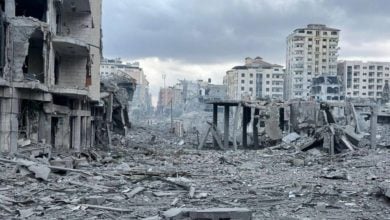As the NATO summit in Lithuania concludes, there is no doubt that the alliance remains fully committed to its profoundly dangerous proxy war against Russia in Ukraine. Headlines in corporate media outlets have been focused on Ukraine’s demand for immediate admission into NATO, which was not granted. But this hyperfocus conceals the bigger picture: the U.S. government and its allies are continuing to escalate the conflict in major ways.
To take one glaring example: Just last week, the Biden administration announced that it would provide Ukraine’s military with cluster bombs. These illegal weapons are banned by most countries in the world, even including NATO countries. The Pentagon hopes that these munitions can help overcome dwindling supplies of regular artillery shells and breathe new life into the stalling Ukrainian offensive that is currently underway. It is a sign that they are committed to the war for the long haul.
Admission into NATO while the war is ongoing was always highly unlikely. Although the most extreme militarists wanted to create the impression that it would be possible, this was never realistically on the table because of Article 5 of the alliance’s charter. If any country in NATO is attacked, then all members of NATO pledge to go to war as well. If the NATO summit had decided to admit Ukraine, that would be a de-facto declaration of war on Russia – effectively a third world war.
That the NATO leaders were unwilling to take this apocalyptic step should not be taken as an indicator that they are “losing their resolve” to back Ukraine, as some major outlets are suggesting. Every few months, the United States and its allies break a new taboo and decide to send a new weapons system that had previously been considered off limits. Before cluster bombs, it was fighter jets – announced just days before the G7 summit in Japan in May. Before that, the announcement that NATO powers would send tanks constituted the big escalation, which came several months after the decision to ship the advanced HIMARS missile system.
And even though Ukraine did not formally become a member of NATO, there were still political steps taken at the summit that make a direct clash between western militaries and Russia more likely. The summit formalized the creation of a permanent “NATO-Ukraine Council” – a standing body that can be convened by either side at any time to coordinate on military matters. And the summit also took the decision to put Ukraine on an expedited path to membership once the war ends.
Whether or not the war in Ukraine turns into a catastrophic direct conflict between the two main nuclear-armed powers remains an open question hanging over the head of every person on the planet. And what we already know for certain is that enormous sums of money are being wasted pursuing this proxy war strategy. Well over $100 billion has been spent by the U.S. government alone, lining the pockets of executives at weapons manufacturing companies who grow rich off of death and destruction. The NATO leaders appear as determined as ever to keep this endless supply of armaments flowing, regardless of the consequences.






